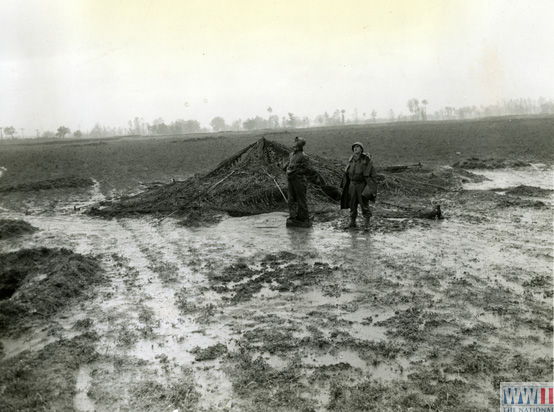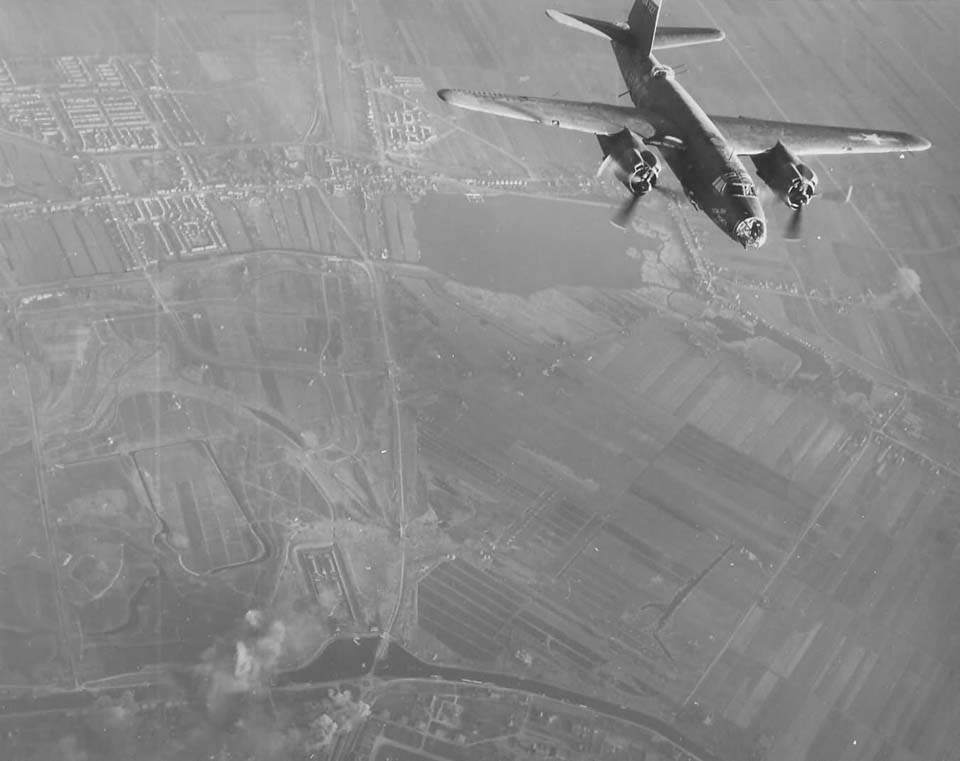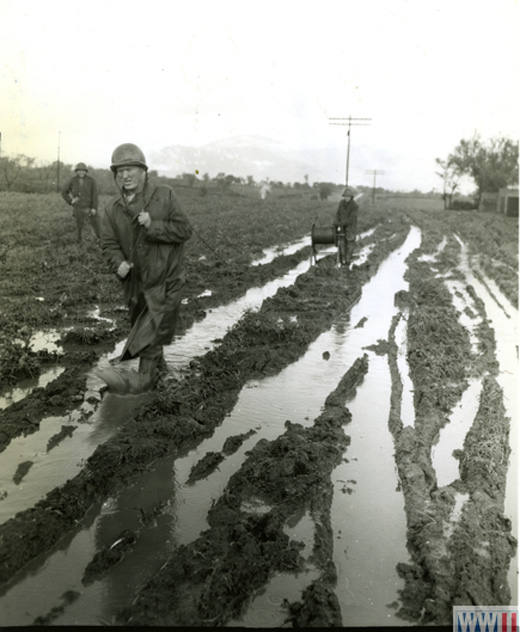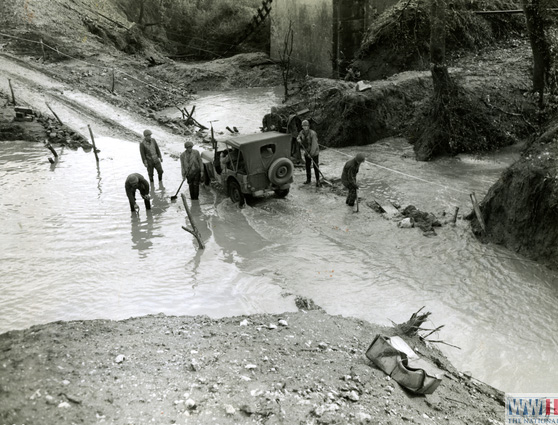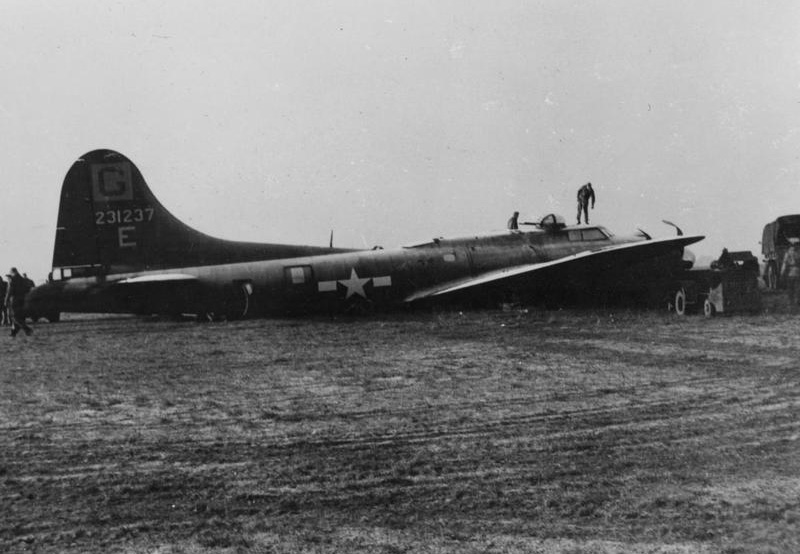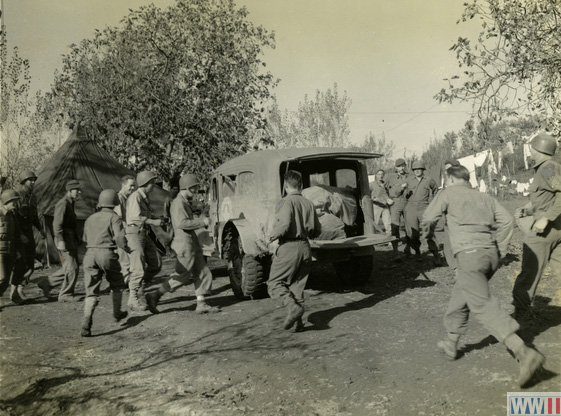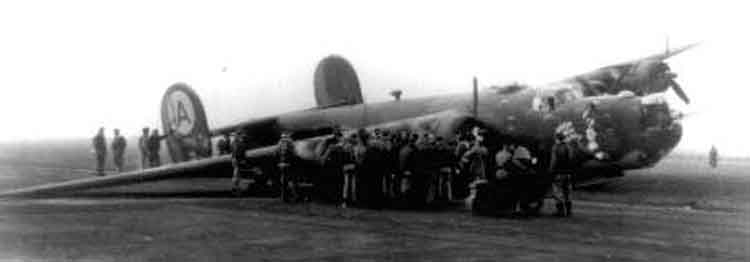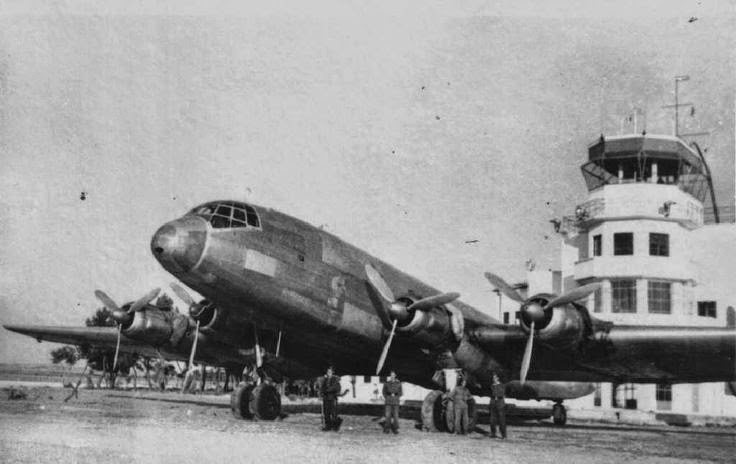Air Operations, Algeria
P-39s of the 350th Fighter Group's 347th Fighter Squadron, and Beaufighters of the 414th Night Fighter Squadron team up with British and French airmen to repel an attack by 30 Luftwaffe night bombers against Allied shipping in Bougie harbor. At least 5 FW-200s, 4 He-177s, and 2 Do-217s are downed by the Allied fighters, and several others are damaged or probably downed, but not before a glider bomb released byne of the Luftwaffe bombers sinks a troop transport.
[Air Operations, Bismarcks
V Bomber Command B-24s attack Gasmata and a Japanese cruiser at Ubili.
[Air Operations, CBI
BURMA- Although the day’s heavy-bomber mission against Rangoon is scrubbed because of heavy weather, 13 RAF Wellingtons attack marshalling yards in the city during the night.
- 5 11th Mediums Bomb Squadron B-25s and 16 14th Air Force P-51s and P-40s attack the airfield at Kiangling, 2 B-25s attack a freighter on Honghai Bay, and 12 P-40s attack boats in the Changte-Tehshan area.
- 8 14th Air Force P-40s attack rail facilities at Cam Duong.
Air Operations, Europe
Using the greatest number of planes to this point, 663(633?) bombers of the US 8th Air Force attack Bremen. The weather is adverse, however, and the results are modest.
RAF BOMBER COMMANDBattle of Berlin
Evening Ops:
- 443 Lancasters are sent to Berlin with 7 Mosquitoes in supporting roles. 28 planes abort.
- In an effort to divert attention from the planned Berlin raid, a diversionary raid is made on Stuttgart by 157 Halifaxes and 21 Lancasters. During the first part of the outward trip it is quiet because of cloud cover. The clouds clear near Frankfurt and the night fighters attack. 5 bombers are lost in this area. The bomber stream divides 30 miles past Frankfurt with the Stuttgart force turning due south and the Berlin to the northeast. Near Berlin one of the Pathfinders drops markers nearly 9 miles northwest of the Aiming Point, but the following Blind Markers retrieve the situation by droppiing markers along a line leading to the center of the city. The main force reponds well. The time over the target is 21:13-21:27. About 1,624 tons of bombs are dropped: 889 of high explosives and 735 of incendiaries.
- The results, however, report that most of the bombs do not fall on the intended target area in the southwest and central parts of the city but in an area 3-5 miles to the north. The districts of Reinickendorf and Borsigwalde are the ones hit.
- The residential areas here make poor bombing targets as the streets are wider and there are more open spaces. But, by chance, important war industry facilities are located here. The Alkett tank factory, the Rheinmetall-Borsig works, the Mauser weapons factory are all hit among others. 981 buildings are listed as destroyed, 6,347 as seriously damaged and 55,000 as slightly damaged. 470 people are killed, 2,091 are injured and about 25,000 are bombed out of their homes.
- On the return flight to England, fog and mist appear over all the bases south of Yorkshire. About 350 planes are sent to land at Yorkshire bases or more distant ones or attempt to land in the fog short of fuel. 20-30 planes crash or crash land with 15 being badly damaged and written off.
- In the Stuttgart raid, the bombing is very scattered and causes little damage but part of the night-fighter force is drawn off from the Berlin operation.
- 28 Lancasters are lost with 15 more being destroyed in crashes and accidents upon returning to England. Aircrew casualties include 196 killed and 35 POWs. 6 Halifaxes are lost in the Stuttgart raid.
- 19 Wellingtons and 14 Stirlings lay mines off Texel and in the Frisians and there are 5 OTU sorties.
FRANCE:
- 350 VIII Bomber Command B-17s, 77 B-24s, and 13 pathfinder B-17s attack the city of Bremen with 1,205 tons of bombs between 1145 and 1228 hours.
- 33 B-17s and 3 B-24s are lost; 10 crewmen killed, 215 missing
- VIII Fighter Command dispatched 353 P-47s and 28 P-38s to escort and support the bombers. 34 Luftwaffe aircraft are downed over Germany, the Netherlands, and France between 1030 and 1400 hours.
FRANCE:
- During the morning, IX Bomber Command's 323rd Medium Bomb Group attacks the Cambrai/Epinoy Airdrome, and the 322nd and 386th Medium Bomb Groups mistakenly attack the Roye/Amy Airdrome instead of the Rosieres-en-Santerre landing ground.
- During the afternoon, secret military construction sites at Audinghen are attacked by B-26s from the 323rd, 386th, and 387th Medium Bomb Groups.
ITALY:
- 376th Heavy Bomb Group B-24s attack rail bridges at four locations.
- 2nd and 99th Heavy Bomb Group B-17s attack a viaduct.
- 301st Heavy Bomb Group B-17s attack a marshalling yard and a bridge at Rimini.
- 17th Medium Bomb Group B-26s attack Cassino.
- NATAF aircraft attack a marshalling yard and the harbor at Ancona, troop concentrations at two locations, and several strongpoints in the battle area.
Allied Planning
The first part of the Cairo Conference comes to an end without any definite decisions having been reached about Operation OVERLORD, the invasion of northern France. In the spring of 1944, with the help of Chiang Kai-shek's forces, communications are to be re-established between India and China by recapturing northern Burma. Roosevelt and Churchill leave for Teheran, where they are to meet Stalin.
[Air Operations, Gilberts
- Following up on a de facto occupation by US Marine scouts, a large occupation force is landed at Abemama Atoll, where a new airfield is to be constructed. A new airfield is also to be constructed in Makin Atoll.
- The first American airplane to land at Hawkins Field, Betio is a VMJ-353 R4D.
Air Operations, New Guinea
- Nearly 40 V Bomber Command B-25 and B-26s attack barges near Sio while V Fighter Command P-40s and P-47s attack occupied villages and targets of opportunity around Alexishafen, Madang, and Nubia.
- 8th Fighter Group P-40s and 35th Fighter Group P-39s turn back a Japanese bomber force on its way to Finschhafen and down 7 Ki-43 'Oscar' fighters and 2 A6M Zeros between Finschhafen and Saidor between 1100 and 1130 hours.
Air Operations, Solomons
More than 40 XIII Bomber Command B-24s, more than 30 42nd Medium Bomb Group B-25s, and more than 30 AirSols fighters attack the Bonis and Buka airfields on Bougainville. 1 B-25 attacks the airfield at Ballale Airdrome. Several US Navy PVs attack Nissan Island in the Green Islands.
[Battle of the Atlantic
In the North Atlantic U-764 shoots down a B-17 aircraft of Coastal Command.
[Bougainville
The Japanese evacuate Grenade Hill, allowing the 1st Battalion, 9th Marines, an easy victory. The I MAC continues to expand the perimeter of the beachhead. The 3rd Division is not at the southern shore of Lake Kathleen.
[Eastern Front
The Soviets take Gomel which has been threatened with encirclement for some time.
CENTRAL SECTORThe 48th and 11th Armies force the LV Corps of the 9th Army out of Gomel. The attack then continues in the direction of Zhlobin but progress is slow.
[Gilbert Islands
American units land on the atoll of Abemama and begin to fortify it.
[Mediterranean
A British troop transport, the Rohna is sunk off Bougie, Algeria by an Hs-293 glider bomb and 1,115 passengers are killed. 8 of the attacking aircraft are shot down.
[New Guinea
The Australians capture Sattelberg.
[Pacific
- The US submarine Bowfin (SS-287) sinks the Japanese army tanker Ogurasan Maru (10,052t) and the merchant cargo ship Tainan Maru (5407t) about 20 miles off the coast of French Indochina.
- The US submarine Ray (SS-271) sinks the Japanese transport Nikkai Maru (2562t) southwest of Truk.
- The US submarine Tinosa (SS-283) sinks the Japanese army cargo ship Shini Maru (3811t) southwest of Palau.
Scenes from November 26, 1943
|
|
|
|
|
|
|
|
